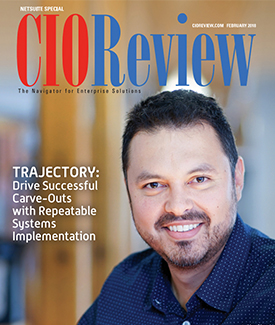Trajectory’s CEO tells us how meticulous cutover implementation is the key. Get to know our team leader and learn from his ERP experiences.
Drive Successful Carve-Outs with Repeatable Systems Implementation
Picture yourself behind the wheel of a beautiful vintage car. Manual transmission. Let’s say that you’ve just purchased this car from a seller who quickly departed following the transaction.
Eager to get home, you put the keys in the ignition, but the car won’t start. You fiddle with the key, the clutch and the brakes–finally engaging the engine. Then more trouble comes your way every time you shift gears. The car jerks and fusses and the vehicles behind you begin to honk. You find yourself wishing that the previous owner had stuck around a bit longer to share a thing or two about how this car runs.
Every car has its quirks and its sweet spot, and the same goes for every carve-out. Carve-out transactions are, by nature, high pressure and fast-paced, bringing with them the prime conditions for stalled operations–sweeping people and resources up, and relegating financial and operational systems to the back seat. Trajectory’s CEO, Alex Olano says that carve-out success is dictated by the company’s ability to be running smoothly from the jump, making understanding the constraints of the Transition Services Agreement (TSA) a critical component to their clients’ success.
While it is no secret that carve-outs pose unique issues and challenges, there are a few lesser-known factors that can quickly derail the transition and put the timeline, costs, TSA terms and relationship at risk. Today, Olano shares with CIO how these five factors can directly influence the success – or failure – of your carve-out transition.
Trajectory Group in Action: Success from Day 0
Challenge: A California-based Private Equity firm had to merge two companies within a 3-month span. In response to their increasing needs, including the growing business, additional team members and financial reporting requirements, Trajectory’s client needed to build continuity into their processing system.
Solution: Trajectory implemented a successful ERP migration using an agile methodology driven by the client’s priorities. Though the timeline was tight and the migration complex, Trajectory was able to utilize a tutorial approach to successfully cleanse and migrate data into the consolidated solution.
Results: Delivered on time and on budget, the client was ready to begin operating smoothly from the start, having undergone extensive planning and training processes, and having clearly established lines of communication with stakeholders. The company continues to utilize its unique, cloud solution to streamline its booming new business.
1. Legacy Leverage
Taking stock of the key applications, the business processes they support, and their inputs and outputs (including interfaces, configurations and reports) is an essential first task for every quality diligence process. When preparing to redeploy an ERP, the tendency is to focus on obvious elements like accounting and finance, billing, revenue management and data. While all of these processes are important, it is often the infrequently used legacy applications that can cause the most trouble downstream. In over 85 percent of the carve-outs in which Trajectory has participated, I’ve been able to design these lower-level processes and smaller legacy applications into the NetSuite solution,” says Olano.
“This ensures that the transition team doesn’t discover these applications too late – once their responsible team members are long gone.”
Alex Olano
President
Trajectory Group
2. Who, What, Where?
Carve-out and M&A scenarios produce competing priorities. Successful carve-outs develop a clear understanding of the key stakeholders, subject matter experts and application owners available to the implementation team early on. “Trajectory’s methodology calls for a roles and responsibilities matrix that includes technical resources, primary end-users and key departmental and process owners,” says Mr. Olano. “With this matrix in place, all teams possess a framework for sourcing key information and decision making responsibilities, enabling them to quickly resolve challenges.”
3. Plan to Prioritize
While each Private Equity transaction is unique, one common challenge is timeline constraints. Utilizing a flexible platform like NetSuite makes it that much easier to provide timely solution design and project phasing built specifically to meet the needs of the individual transaction.
Trajectory prioritizes deliverables by determining which elements are truly mission-critical to begin operations. A special focus is placed on billing, running projects and other key business activities. Elements that can be phased are identified, and incomplete components are supported by a tailor-made NetSuite support. “The key here is to value functionality and operational capability – not perfection,” says Olano.
4. Data Dilemmas
Due to the highly-sensitive environments surrounding carve-outs, significant proprietary information (i.e. historical data) is often excluded from the diligence and transaction. To combat these challenges, Trajectory developed a carve-out and M&A transaction-specific data migration methodology. The essential elements include:
- Group and identify the types of data, including those ineligible for direct migration.
- Establish ownership – both from a legal as well as a migration perspective.
- Develop an accurate timeline and anticipate roadblocks by planning complete test cycles for all data types.
- Assign data cleansing leads from both sides of the transaction to meet regularly and address outstanding issues.
“We’ve found that these four steps really cover all the bases for our clients, regardless of how complicated the individual situation may be,” says Olano.
5. Zero to Sixty
A successful ERP migration is ultimately defined by one question: Could the business operate successfully right out of the gate? With all of the effort and energy invested in the system migration, it is the cutover preparation and execution that defines the project. Training – including how-to videos, group follow-ups, and office hours support from your ERP platform implementation consultant ensure that the entire end-user group has the support needed to be successful.
“Trajectory utilizes our own approach to test the team’s self-reliance by providing a highly designed hybrid of end-user testing and end-user training,” says Olano. “By leveraging on-site testing, we ensure that a broad group of users are well trained, self-reliant and ready to lead.”
Carving-Out? Avoid the 3 Most Common Challenges
Team Confusion: Who is staying, and who is going? Who will be responsible in the future? Competing allegiances are common in carve-out transactions, and team members “picking sides” often complicate matters- particularly when the future org. charts are not yet in place. Clear communication and extra planning is the key to keeping the team on the same page.
Data Migration: Legacy data is a notoriously contested issue, rife with privacy concerns and proprietary challenges. Resist the temptation to sweep this complicated factor under the rug. Many teams run into trouble as they seek to migrate necessary data once the responsible team members have parted ways. Establish responsibilities and ask questions up-front before it’s too late.
Tight Timelines: Prioritization is essential to carve-out success, given that the timelines are typically so short. Don’t let the big picture cloud your judgment on immediate decisions. Focus on the mission-critical tasks first, and take them one step at a time.
Choosing the Right Implementation Partner — A Playbook for Repeatability
Though carve-outs are notoriously complex, each presenting its own unique set of challenges, partnering with an implementation consultant can help to establish operational and functional goals, develop beachheads and templates, and focus on delivering results that are repeatable. “Trajectory has honed our approach to guiding and supporting the migration of key finance and operational systems over dozens of successful transactions,” says Olano. “We’re a full-service NetSuite consultancy, capable of providing support and expertise for every phase of an organization’s NetSuite solution.”
Time Flying until Cutover? Grab a Parachute from a NetSuite Implementation Expert
Carve-out transactions are high-pressure and fast-paced, and migrating assets into a new, comprehensive ERP that blends the needs of both the acquiring and incoming companies is a challenge best left to the experts.
Partnering with a Private Equity NetSuite Implementation Expert helps your organization to mitigate the risk associated with lost data, applications and relationships. Since 2005, Trajectory has helped hundreds of companies improve operational efficiency and increase stakeholder value through a mix of hands-on business consulting and the right technology.
About Trajectory Group
Trajectory has led and participated in over 220 NetSuite implementations and over 70 M&A projects to implement financial, operational and revenue solutions, migrate processes and data, and thoroughly train the end-users. Trajectory builds solutions for companies just like yours, and it’s their characteristic drive for improvement – a constant pursuit of better–that truly sets them apart.










